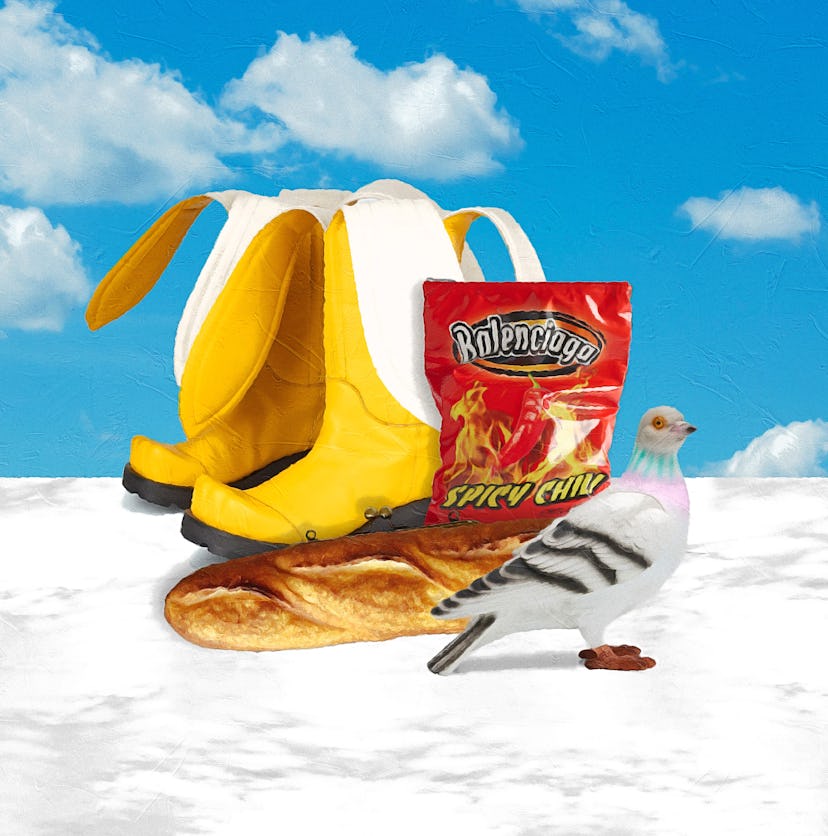Style
Everyone Wants A Bag That Looks Like A Tomato. Or A Pigeon. Or A Shoe Box.
For extremely online fashion fans, there’s nothing like an absurdist accessory.

In June, a user on X shared photos of a downright sexy heritage tomato: heart-shaped with a sinuous, undulating curvature, and a mouthwatering bright red hue. “This tomato is so Loewe I can’t explain it,” they wrote.
The post went viral, and Loewe designer Jonathan Anderson responded by sharing a peek at a remarkably similar, yet-to-be-released tomato clutch. Even though he’d conceived of the bag well before that hot-*ss tomato was circulated online, he captioned his post “Loewe meme to reality.”
Washington Post fashion critic Rachel Tashjian was surprised to see more chatter online about the bag than Loewe’s campaign images with Daniel Craig, which came out around the same time.
“Typically the way that fashion works, people get really excited about these celebrities wearing clothes,” she says. But as it turns out, the tomato clutch had more main-character energy than Benoit Blanc. “These products become this sort of entertainment within themselves, but then they’re also products, so they draw people’s attention back to the actual creative output of the brand. … They allow brands to play both sides of the coin.”
By “these products,” Tashjian is referring to the loose, know-it-when-you-see-it category of the things that look like other things. A Balenciaga bag that looks like a shoebox; a pair of Charles Jeffrey Loverboy boots that look like bananas; a JW Anderson sweater that looks like a house, complete with a bird resting on the “roof.” Vaquera made a scarf that resembles a string of dollar bills. Susan Alexandra sells beaded bags and jewelry that resemble everything from shrimp to Champagne glasses. Puppets and Puppets has become almost synonymous with its cookie bags. The trend isn’t limited to clothes and accessories — that corn-shaped stool is a micro trend in itself — but it’s particularly pronounced in the fashion industry.
During the tomatossance, the Internet asked plenty of questions: What does the rise of groceries as luxury goods say about the Ozempic era? Why are we looking at the world with brand vision, sorting the most organic of objects into aesthetic categories cultivated by capital? Where does one even find such a titillating tomato, and are there more where that came from? But by focusing narrowly on the intersection of fashion and produce — admittedly, a growing niche — the online conversation elided the larger trend the bag represented.
“Perhaps it’s reached its peak, fascination with things that are not what they seem,” says Olivia Cheng, the designer behind Dauphinette, a brand that’s become known for things that look like other things — and for taking them a step further, by making bags out of actual baguettes, and jewelry out of actual flowers. “Right now, there are truly too many options, so many options, [and] I think it takes something that is both surprising but feels familiar to really stand out.”
This isn’t a new idea in fashion; it’s been around at least since the days of famed 20th century designer Elsa Schiaparelli and her surrealist peers (see: the rotary phone dial-as-powder compact she created with Salvador Dalí), and has appeared regularly since, in the camp of Moschino, the subversiveness of Margiela, and the bedazzled output of Judith Leiber. But in the past couple of years, examples have proliferated, and the Internet is eating them up.
Perhaps the most widely celebrated artifact to emerge from this boom is JW Anderson’s pigeon purse, which famously earned a cameo on And Just Like That. (Unlike the infamous Judith Leiber bag Big gifted her back in the day, Carrie loves the pigeon.) Anderson told Harper’s Bazaar that he originally imagined the bag as a gag for his men’s Fall 2022 runway, to provide levity amid a COVID-19 surge. The joke, aside from its obvious impracticality, was in elevating the common pigeon to the realm of luxury. Can you imagine, carrying around a sky rat?! But the audience called his bluff: The online response to the bag was so effusive that he wound up producing and selling the bag for $980 a pop.
The current vogue for things-as-other-things is inextricable from the way they circulate online. After all, you don’t wear a pigeon purse because you need a place to stash your cash and lip oil; its only real use is to be seen. And nowadays, everyone’s dressing for the photo (or TikTok video, or Instagram reel, or YouTube short, or…).
What is it, exactly, about these objects that sparks engagement? Perhaps it’s the mismatch between surface and interior — the “Is it cake?” school of memery. It could be the sense of delight that accompanies collapsing categories: Our brains are wired to group things and decipher patterns, and there’s a certain joy that comes with subverting expectations. Or maybe you can chalk it all up to the Internet’s love of absurdism and extremes, especially in topsy-turvy times like these. Kamala is brat; shoebox is purse. (Absurdism, the urge to collage, anxiety around media and technology? RIP Dada artists, you would’ve loved 2024.)
“The meaning has sort of broken down, and we’re just sort of throwing memes at each other to attempt to communicate across the morass,” Tashjian says.
In a moment when just about everything is cloaked in several layers of irony, and just about the worst thing you can be is earnest, the only logical solution is to play the game. This way, fashion brands can ensure they’re in on the joke, rather than the object of ridicule — you know, cover their butts with shorts that look like butts.
Best get used to that trompe l’oeil because it seems like it’s here to stay.